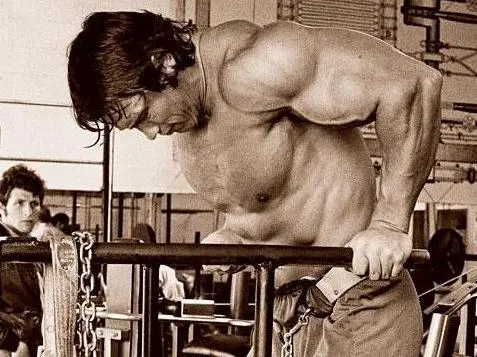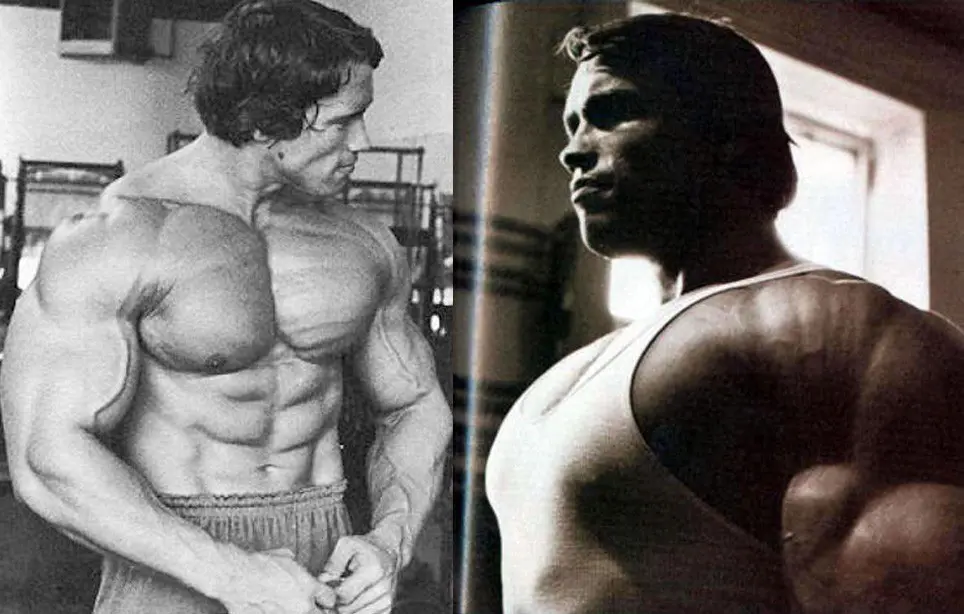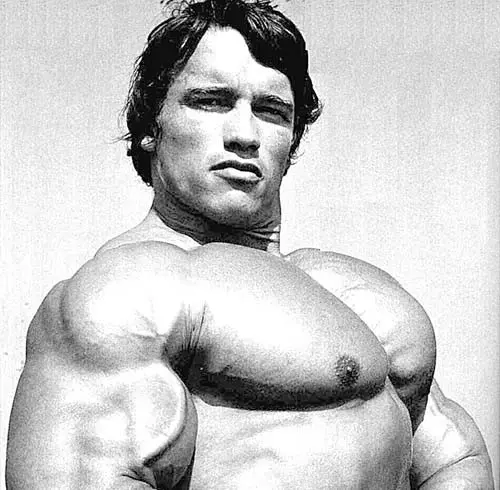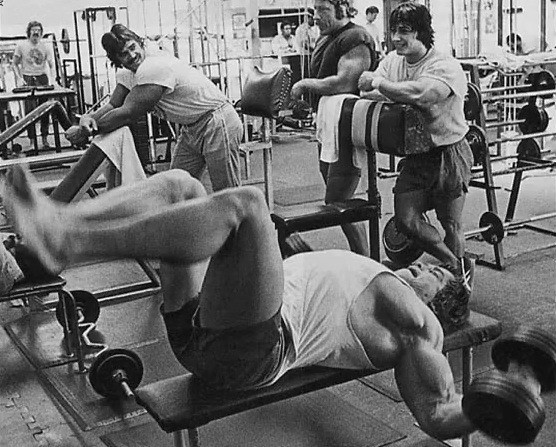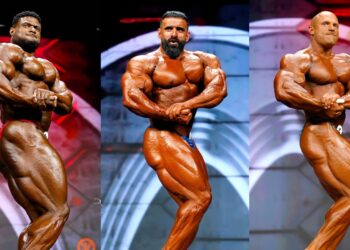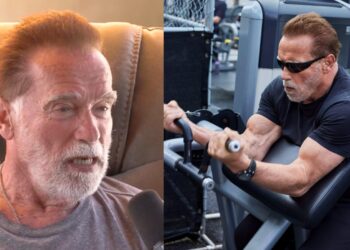Advantages
As Arnold explains it, there are several advantages to alternating chest and back exercises.
- It saves time and the workout goes much faster.
- You can handle heavier poundages for more mass power.
- You get a greater pump and a continuous flushing effect of both areas for the entire workout. You keep the pump longer.
- Greater muscle density results because you are able to work to the absolute limit of your physical capacity.
One of the most important reasons why a chest-back superset program works so well is the fact that most chest exercises are pushing movements, while all back exercises are pulling exercises. The chest muscles are resting during the last exercise and the lats are resting during the chest movement. While each muscle is alternately resting and working, it stay’s fully flushed and pumped up…. When the chest and upper back are pumped simultaneously, there is an indescribable feeling of growth stimulation and massiveness.”
The Exercise’s
Here’s a synopsis, complete with some of Arnold’s thoughts about each of the pec exercises he used in this training regimen and how he employed them.
Exercise 1: Barbell Bench Presses
Arnold would first warm up for this favored exercise with 135 pounds for a quick 30-40 reps to get the blood flowing and the joints loose. Then he would immediately head for a chinning bar, knocking out 15 wide-grip behind-the-neck chins before heading back to the bench, adding a pair of 45s to the bar and pumping out 20 more reps.
After a second set of chins, he’d load the bar with 275, perform 15 more reps and then jump back to the chinning bar. And so it went, with weight/rep combinations of 315 for 12, 365 for eight and 405 for six, all superset with chins, all done without rest. Arnold always consciously took very deep breaths while doing this and all of his chest exercises.
“In addition to massing up the pectorals, the heavy breathing also encourages rib cage expansion.”
Get Fitter, FasterLevel Up Your Fitness: Join our 💪 strong community in Fitness Volt Newsletter. Get daily inspiration, expert-backed workouts, nutrition tips, the latest in strength sports, and the support you need to reach your goals. Subscribe for free!
Exercise 2: Incline Barbell Presses
“This movement is unsurpassed as a builder of the upper pecs.” With his pecs now fully warmed up, he would jump right to 225 pounds for an initial 15 reps; again concentrating on deep breathing as well as flexing his pecs throughout the movement.
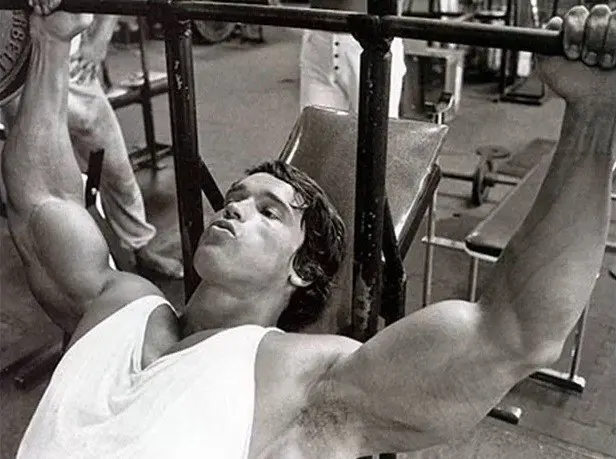
By this point, Arnold’s pecs and lats would be flushed with blood.
Exercise 3: Flat Dumbbell Flyes
Here is a great exercise to shape up the outer sections of the pectorals and that, when performed correctly, also opens up the rib box and helps to deepen the chest.
A master of technique, Arnold perfected this difficult movement as no one else ever had. He often described the motion of the flye as “hugging a tree.” Lying back on a flat bench, with arms slightly bent, he would take a huge breath and slowly lower the dumbbells out and away from his torso, so low that they would practically touch-the floor. Then, with a mighty exhalation, he would raise them back through the same arc, all the time squeezing his pecs. What set Arnold’s technique apart from that of nearly everyone else was his form at the top of the movement. As the tension on his pecs would begin to decrease near the movement’s end, he would stop his motion, with the dumbbells remaining 10-12″ apart. He realized that anything beyond that was wasted movement having no impact on his pecs.
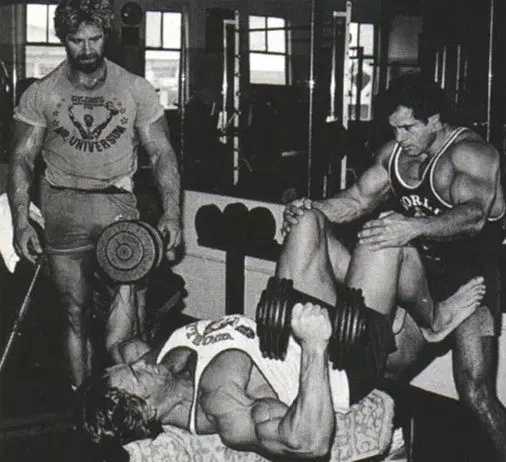
Exercise 4: Parallel Bar Dips
Dips, Arnold felt they carved a clean line at the bottom edge of his pectoralis major like no other exercise.
With an 80-pound dumbbell strapped to his waist, he would prop himself up on dipping bars and then slowly lower himself to a point where his hands nearly touched his armpits. Lie then exploded back up, all the time making sure to synchronize his breathing to the pace of the movement and inhale on the way down, exhale on the way up. He’d blast out 15 reps and then perform a set of close-grip chins for each superset.
“By the time I get to the fifth set, the pecs and lats are totally engorged with blood and I have such a colossal pump that the muscles feel like they are going to burst through the skin!”
Exercise 5: Stiff-Arm Pullovers
With the chest-back supersets out of the way, Arnold would complete the lifting portion of his workout with pullovers to stretch his pecs, lats and rib cage simultaneously. This exercise was always a staple of Arnold’s training and the one he considers most responsible for the overwhelming size of his rib box. Lying across a flat bench, he would grab a dumbbell of what he considered medium weight with both hands and extend it to arms’ length, keeping a slight bend in his elbows. From here, he would lower the weight in an arc down past his head while inhaling very deeply through his mouth, all the while making sure to keep his hips down, thus ensuring the greatest possible stretch.
Despite a nearly incapacitating level of fatigue by this point, he would still manage to force out five, sets of 15 to 20 reps with a 90-pound dumbbell. Between sets, he would pause for about 30 seconds, during which time he would walk around the gym taking deep breaths while forcing his chest to its maximum point of expansion.
“You will not believe the ache in the sternum that this movement will produce! It literally pulls your chest apart and forces it into new growth.”
Level Up Your Fitness: Join our 💪 strong community in Fitness Volt Newsletter. Get daily inspiration, expert-backed workouts, nutrition tips, the latest in strength sports, and the support you need to reach your goals. Subscribe for free!
Exercise 6: Iso-Tension Contractions
No matter what the bodypart, Arnold would always finish up his workout with an intense session of posing and flexing.
“I’ pose my chest by doing the side chest pose where the rib cage is fully expanded with the sucked in. I do this from waist both sides. Then I squeeze and crimp the pecs as hard as I can from all angles to bring out the height, thickness and shape. This not only gives me better control of these muscles, but it also brings out all the veins and muscular striations, which improves the definition.”
Celebration
Finally, after a solid hour of this nonstop self-inflicted torture, Arnold would be drenched in sweat as if he had come in from a rainstorm. His chest and back muscles would throb and ache. His breathing would be labored. To anyone else, this condition would prompt an immediate visit to the nearest emergency room. To the Austrian Oak, it was reason to celebrate.
“As I head for the shower, I feel exhausted but exhilarated, like a boxer who has just gone 15 rounds with the heavyweight champion and beaten him with a knockout in the final round!”
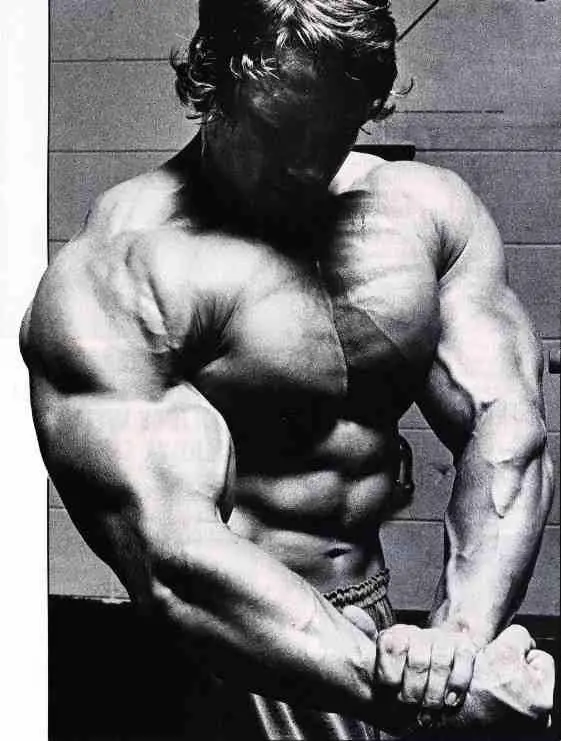
Of course, Arnold Schwarzenegger wasn’t “most” bodybuilders, was he?
Arnolds All Out Chest-Back Workout – Sets/Reps
- Bench presses * 1x 30 – 45
- Bench presses 5x – 6
- Wide-grip behind-the-neck chins 5 15-8
- Incline barbell presses 5x 10-15
- T-bar rows 5x 10-15
- Flat-bench dumbbell flyes 5x 10-15
- Wide-grip barbell rows 5x 10-15 (performed standing on a block for better range of motion)
- Dips 5x 15
- Close-grip chins 5x 12
- Stiff-arm pullovers 5x 15-20
- Iso-tension contractions (finishing exercise)
* Performed as a warm-up.
Note:
Arnold took absolutely no rest between sets and exercises of the four supersets.
Early Chest
This is the chest routine Arnold Schwarzenegger used three times a week at the start of his bodybuilding career. Although science has provided little evidence that one can actually alter the size of a thorax after puberty, Arnold believes otherwise. “I am convinced,” he says, “that I could effectively expand the rib cage by performing dumbbell pullovers.” Hard to argue with the evidence!
Exercise Sets/Reps
- Bench presses 5x 6-10
- Incline bench presses 5x 6-10
- Flat bench flyes 5x 6-10
- Dips 5x 6-10
- Dumbbell pullovers 5x 6-10
Doing The Double Split
No, it has nothing to do with the gasp-inducing tendon-stretching pose performed by people such as Phil Hill, Flex Wheeler and Ronnie Coleman on a bodybuilding stage. “Double split” refers to a type of training routine that has pretty much gone the way of baggy posing trunks and kettle bells. Specifically, a double-split routine is one in which the body is split into several groups, each to be trained in separate workouts, with two workouts performed each day (usually one in the morning and one in the evening) amounting to double the training performed in a normal split routine.
In the 1970s, it was all the rage, with some athletes, such as Roy Callender, not leaving the gym at all during the day, instead performing all-out workouts lasting up to eight hours!

Arnold preferred a two-day split, going six days on and one day off, which means he trained his whole body within two consecutive days, three times per week. That schedule is presented here.
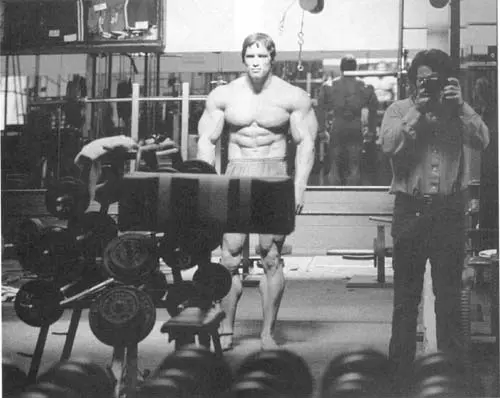
Arnold’s Double Split
- Day 1 Chest, back (Morning) Thighs, calves, abs (Evening)
- Day 2 Shoulders, arms (Morning) Calves, abs (Evening)
- Day 3 Chest, back (Morning) Thighs, calves, abs (Evening)
- Day 4 Shoulders, arms (Morning) Calves, abs (Evening)
- Day 5 Chest, back (Morning) Thighs, calves, abs (Evening)
- Day 6 Shoulders, arms (Morning) Calves, abs (Evening)
- Day 7 Rest
Chest Be Careful
The all-out chest back workout should be performed only by experienced bodybuilders. Occasionally, even top-level bodybuilders attempting to keep up with Arnold have lost consciousness or, in at least one instance, their lunch. Amateur and intermediate-level bodybuilders interested in utilizing the principles set forth in this regimen are strongly advised to modify the routine to suit their particular level of expertise.
For example, where Arnold might specify five supersets of a pair of exercises, consider performing two or three, with increased rest between supersets, to avoid overtraining and possible injury. As strength and stamina grow, the volume and speed of the workout can be slowly increased.
References:
muscleandfitness.com & www.flexonline.com
Copyright 2010 Weider Publications


